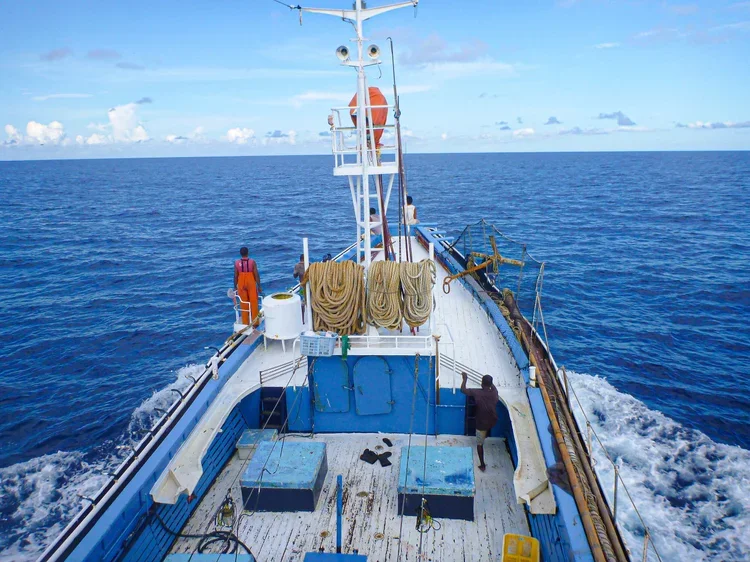As I recently presented, my colleagues Efthymios Papastavridi and Antonios Tzanakopoulos (Oxford University) have completed the UNODC Issue Paper that discusses the surveillance and enforcement of marine protected areas in the high seas, highlighting the need for integrated management to conserve biodiversity amidst increasing human activities.
My contribution was drafting large parts of section II (Earth Observation Tools used to Monitor MPAs). I appreciate the specific acknowledgement of my role in the document by both academics. This Issue paper, as far as I know, is the deepest and most contemporary analysis of how MCS could work in Marine Protected Areas, in Areas Beyond National Jurisdiction.
As always, I recommend you read the original, and for the lazy among you, below is an AI-generated summary that surely does not do justice to the whole paper.
Introduction
High seas, covering 64% of the world’s oceans, lie beyond the territorial jurisdiction of any state. These areas are ecologically significant yet highly vulnerable to human activities such as shipping, fishing, seabed mining, and waste dumping.
The paper focuses on the legal and practical challenges surrounding surveillance and enforcement of Marine Protected Areas (MPAs) in the high seas, particularly under the newly adopted BBNJ Agreement (2023).
Global Conservation Targets
UN SDG 14.5 (2020 Target): Conserve 10% of oceans via MPAs—missed; only 2.9% protected as of 2025.
Kunming–Montreal Global Biodiversity Framework (2022): Protect 30% of marine and coastal areas by 2030.
Governance Challenge
Current governance is fragmented and sectoral, relying on:
RFMOs for fisheries closures.
IMO for shipping-based ABMTs (e.g., PSSAs).
ISA for seabed mining (APEIs).
Lack of cross-sectoral coordination and monitoring capacity undermines effectiveness.
The BBNJ Agreement: A Milestone with Gaps
Adopted in June 2023, the Agreement on the Conservation and Sustainable Use of Marine Biological Diversity of Areas beyond National Jurisdiction (BBNJ) provides:
Legal definition of MPAs:
“A geographically defined marine area designated and managed to achieve long-term biodiversity conservation objectives, potentially allowing sustainable use consistent with those objectives.”Framework for ABMTs (Area-Based Management Tools):
Parties submit proposals.
Reviewed by Scientific and Technical Body.
Decisions taken by the Conference of the Parties (COP).
Key Limitations
No robust enforcement mechanism: Implementation relies on flag States.
No compulsory cooperative inspection schemes (unlike fisheries treaties).
Generic reporting obligations, lacking strong compliance tools.
Why Enforcement Matters
Without credible enforcement, the BBNJ objectives—particularly the 30% protection goal—risk remaining aspirational. Enforcement challenges arise from:
Jurisdictional complexity (multiple states and actors involved).
Freedom of navigation principle under UNCLOS.
Gaps in mandatory obligations for states to monitor or prosecute violations.
Maritime Domain Awareness (MDA): Cornerstone of Surveillance
The paper emphasises Maritime Domain Awareness (MDA) as fundamental for monitoring MPAs.
Definition
IMO:
“The effective understanding of maritime activities impacting security, safety, economy, or environment.”
Originating from post-9/11 security frameworks, MDA now underpins environmental governance at sea.
Surveillance Technologies for MPAs
Modern monitoring combines cooperative systems (dependent on vessel compliance) and non-cooperative systems(independent detection).
1. Vessel Monitoring System (VMS)
Satellite-based; mandatory for most commercial fishing vessels.
Provides periodic position data to regulators.
Limitations:
Can be disabled (“going dark”).
Data often not shared across jurisdictions.
2. Automatic Identification System (AIS)
Mandatory under SOLAS for ships >300 GT.
Broadcasts real-time navigational data.
Challenges:
Can be switched off or spoofed.
Small vessels exempt.
Complex datasets require AI-driven analytics.
3. Long-Range Identification and Tracking (LRIT)
IMO system for ships >300 GT.
Offers secure position reporting but excludes small vessels and fishing boats.
Implementation costs questioned by some states.
4. Satellite Remote Sensing
Non-cooperative detection using:
Synthetic Aperture Radar (SAR): Operates in all weather, detects vessels without AIS.
Optical imaging, RF geolocation, night-light detection.
Strengths: Wide coverage, effective against dark vessels.
Weaknesses: Static snapshots are expensive, require expert interpretation and algorithmic support.
5. Artificial Intelligence and Data Fusion
Integrates AIS, VMS, and satellite data to:
Detect anomalous behaviour (e.g., loitering, transhipment).
Predict compliance risks.
Platforms like Skylight, Ocean Mind, Starboard, and Global Fishing Watch lead global initiatives, often partnering with governments and NGOs.
Legal Dimensions of Surveillance
Jurisdictional Framework
Flag State Jurisdiction (UNCLOS Art. 92): Exclusive over vessels on the high seas.
Freedom of Navigation: States cannot interfere with foreign vessels unless exceptions apply (e.g., piracy, slavery).
Surveillance legality:
Passive monitoring (e.g., satellites) does not breach international law if no physical interference occurs.
Rooted in the customary right of approach.
Enforcement Gaps
Flag State obligations: Primarily permissive, not mandatory—unless treaties impose duties.
Port State measures: Effective in fisheries but underutilised for MPAs.
Control over nationals: Possible tool for expanding accountability.
UNTOC: Could convert the optional jurisdiction into mandatory duties to prosecute environmental crimes.
Challenges to Effective Enforcement
Operational: Limited resources for large-area monitoring, especially for developing states.
Legal: Unclear obligations for enforcement under BBNJ.
Evidence: Satellite data admissibility, chain-of-custody concerns.
Cooperation: Fragmented data-sharing among states and agencies.
Key Recommendations
Integrate Surveillance into MPA Planning
Make MDA an operational priority from the outset.
Adopt Data-Fusion Platforms
Combine cooperative and non-cooperative tools for real-time analysis.
Enhance Legal Framework
Expand port State jurisdiction for environmental enforcement.
Require flag State compliance beyond reporting.
Develop cooperative inspection models akin to UN Fish Stocks Agreement.
Leverage Technology
Invest in AI-driven predictive analytics for proactive compliance.
Encourage partnerships with private tech providers (e.g., Skylight, Ocean Mind).
Promote Global Cooperation
Establish shared surveillance databases and joint monitoring initiatives.
Conclusion
The BBNJ Agreement is a historic achievement, creating a global framework for high seas MPAs. Yet, without robust enforcement and surveillance, its goals—especially 30% ocean protection by 2030—remain in jeopardy.
Advanced technology—satellite remote sensing, AI-driven analytics, integrated MDA platforms—offers transformative potential. However, these tools must be paired with:
Clear legal obligations for states,
Stronger compliance mechanisms, and
International cooperation.
Ultimately, the effectiveness of high seas MPAs hinges not only on ambitious legal commitments but also on the political will to monitor, enforce, and share responsibility for ocean stewardship.
